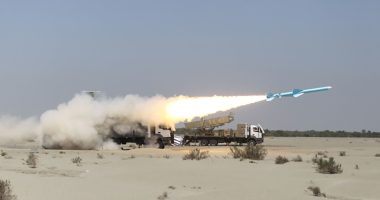The aggressive postures of disruptive states drove arms sales in Europe, the Middle East and Asia during the past five years, according to a new report by the Stockholm International Peace Research Institute (SIPRI).
Russia’s war in Ukraine contributed to a doubling of arms purchases in Europe in 2019-23 relative to 2014-18, the think tank said on Monday, with Ukraine becoming the largest regional importer and fourth-largest in the world.
Arms exports to Asia made up the largest single chunk globally – 37 percent – with United States allies Japan, Australia and India leading the buying spree.
These were “largely driven by one key factor: concern over China’s ambitions”, said Pieter Wezeman, a senior researcher at SIPRI’s arms transfers programme.
Japan, for example, raised its imports two-and-a-half times over, ordering, among other things, 400 long-range missiles capable of reaching North Korea and China.
US allies Qatar, Egypt and Saudi Arabia also led purchases in the Middle East, which accounted for 30 percent of global imports.
“It is not just a fear of Iran. It is actually warfare,” Wezeman told Al Jazeera. “In the past 10 years, Saudi Arabia has actually used those arms in operations which it is leading by itself, including in Yemen. That is considered in Saudi Arabia a direct confrontation with Iran through proxies.”
Regional rivalry also played a role.
Qatar, for instance, quadrupled its arms imports after Saudi Arabia and the United Arab Emirates imposed a blockade on the Gulf country in 2017, ordering combat aircraft from the US, France and the United Kingdom.
“We live in a transitional world. It is fluid and unstable. The UN has a decorative role. There is a whole class of revisionist powers,” professor of history at the American College of Greece Konstantinos Filis told Al Jazeera.
“There is insecurity from Western-friendly states about whether US power can deter an attack on them,” Filis said. “They’re saying, ‘If I don’t rearm, there is no one to protect me, there aren’t multilateral strong mechanisms as in previous years, so I have to prepare for a future attack’.”
US widens lead as top exporter
Western allies are the biggest exporters, too.
The surge in spending by allies helped the US widen its lead as a top arms exporter, reaching 42 percent of the global market, up from 34 percent in 2013-18.
That is partly because the US is the only country with an exportable fifth-generation combat aircraft, the F-35 Lightning II, and many of its allies are now transitioning their air forces to adopt the aircraft’s stealth technology. Europe has almost 800 next-generation fighter planes on order, including the F-35, the Eurofighter Typhoon and France’s Rafale.
But the pattern of upticks in sales to key Western allies, comprising eight of the top 10 arms importers, suggests the bigger reasons are political.
Other Western arms producers have also benefitted. France raised exports almost by half to beat Russia to second place, and Italy nearly doubled them.
Fighter planes have swollen France’s orderbook, with Dassault going from selling 23 Rafale 4.5th generation aircraft in the 2013-18 period to 94 in the past five years. It currently has 193 on order.
In fact, Europe, including the UK and Switzerland, exported 31 percent of the world’s weapons in 2019-23.
South Korea has emerged as a major exporter too, signing big deals with Poland for tanks, artillery, aircraft, and rocket artillery.
China, in contrast, sold 5.8 percent, with 60 percent of its exports going to Pakistan, and most of the rest to Bangladesh and Thailand.
Russia, once the US’s great rival in arms sales, halved its exports to 11 percent of the global share – partly due to husbanding its resources to fight Ukraine, but also due to a longer decline predating its full-scale invasion.
Russian exports have been falling partly because China, a major client since the 1990s, has increasingly been building its own weapons, and India, a long-term buyer of Russian weapons, is beginning to question Russia’s technologies and ability to deliver.
“India seems to be moving away from Russian equipment,” said Wezeman. “There have been some orders that haven’t led to deliveries yet, for example, the nuclear powered submarine which Russia is supposed to deliver this year or next, some frigates, a few aircraft.”
“We also see what seems to be a disappointment on the Indian side about the technical level of the Russian equipment which they have acquired, and therefore a shift to other suppliers such as France and Israel in the past 20 years, and the US.”
A hopeful sign for Europe
It is a hopeful sign, say experts, that Europe has begun to rekindle the forges of its own defence industry, giving it greater agency to supply Ukraine – especially given delays in US military aid.
“It is very clear that Europe is putting in an enormous effort to scale up its production of ammunition and a whole range of other products,” said Wezeman. “It turns out, there is capacity, but of course it is scattered throughout Europe. Much of it has been standing still. There is expertise, there are production lines lying dormant,” he said.
“It’s only when things get really bad that people mobilise,” Suzanne Raine, a former UK diplomat and lecturer at Cambridge University’s Centre for Geopolitics, told Al Jazeera.
“There was a moment at the beginning when Russia invaded and it looked terrible and there was an immediate response,” she said, referring to the first rush of weapons pledges for Ukraine in early 2022.
She believed that Ukrainian success was misinterpreted in the West.
“That moment when it became clear that Ukraine was actually going to be able to hold the Russians back was a dangerous turning point, because it allowed for the first little bit of complacency,” she said.
French President Emmanuel Macron last May called for greater European defence autonomy. Not everyone agrees with that framing of the debate.
“The defence industrial partnerships that protect European nations and support Ukraine cross European boundaries,” Cambridge University historian Hugo Bromley told Al Jazeera.
“Ultimately, the goal should be less about ‘European autonomy’, and more about developing capabilities at national and international levels among friends and allies.
“We mustn’t let the pursuit of ‘European autonomy’ get in the way of providing the best support we can,” he said.
Also Read More: World News | Entertainment News | Celebrity News









